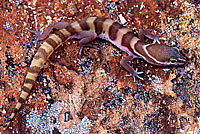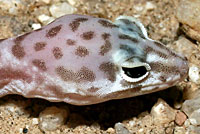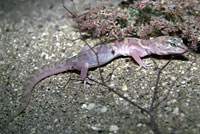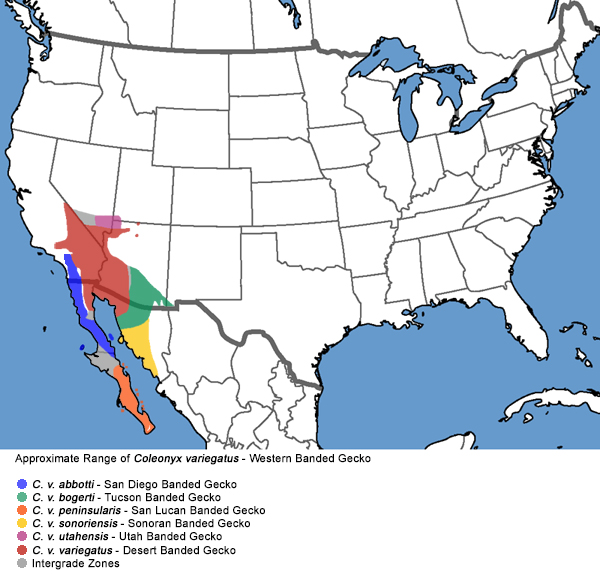|
 |
 |
|
| Adult male, San Diego County © Kahleo Thompson |
|
 |
 |
 |
| Adult male, San Diego County © Blaine Mazzetti |
Adult, San Diego County © Stuart Young |
 |
 |
|
| Adult, San Diego County. © Nathan Smith |
|
| |
|
|
|
| Geckos from Intergrade Areas |
 |
 |
 |
 |
| This juvenile was see at night in mid February crawling on pavement eating ants at the bottom of San Antonio Canyon in San Bernardino County, near the LA County line. © Christian Gingerich |
Night-active adult at the same location as the juvenile to the left.
© Christian Gingerich |
Sub-adult, Riverside County |
 |
 |
 |
 |
| Subadult, Riverside County |
Sub-adult, Riverside County |
 |
 |
 |
 |
| Adult showing some intergrade traits, from near Perris Reservoir, Riverside County |
Adult, Orange County, from a riparian canyon on the western slopes of the Santa Ana Mountains © Mike Pecora |
 |
 |
 |
|
| Adult showing some intergrade traits, from near Perris Reservoir, Riverside County |
|
| |
|
|
|
| San Diego Banded Geckos From Baja California |
 |
 |
 |
 |
| Adult, El Rosario, B. C. Norte |
Adult, El Rosario, B. C. Norte |
Adult, Bahia de Los Angeles, B.C. Norte
© Stuart Young |
Adult, Bahia de Los Angeles, B.C. Norte
© Stuart Young |
 |
 |
|
|
| Adult, Baja California Norte © Paul Maier |
|
|
| |
|
|
|
Comparisons of Banded Geckos in California
Also see Banded Geckos in California - Genus Coleonyx
|
 |
 |
 |
|
Left: San Diego Banded Gecko
Middle: Intergrade
Right: Desert Banded Gecko
All three were found in Baja California where the ranges of the two subspecies meet. © Stuart Young |
Right: San Diego Banded Gecko
Middle: Intergrade
Left: Desert Banded Gecko
All three were found in Baja California where the ranges of the two subspecies meet. © Stuart Young
|
Desert Banded Gecko on the left with a
San Diego Banded Gecko on the right for comparison. © Bruce Edley |
|
| |
|
© Nathan Smith |
© Stuart Young |
 |
 |
 |
 |
Desert Banded Gecko (C. v. variegatus)
Adults have large markings on the head
(but juvenile heads are plain or lightly spotted.)
The nuchal loop extending around the head
from the eyes is irregular or not present.
|
San Diego Banded Gecko (C. v. abbotti)
The head does not have large markings.
A
light-colored clearly-defined nuchal loop extends from
the eyes around the back of the head.
|
 |
 |
|
|
Peninsula Banded Gecko - C. s. switaki
Skin is smooth with small granular scales interspersed with larger tubercles. |
Desert Banded Gecko - C.variegatus
Skin is smooth with small granular scales that are not interspersed with larger tubercles. |
|
|
| |
|
|
|
| Difference Between Males and Females |
 |
 |
 |
|
Males have spurs at the base of the tail. Females do not. Compare
|
|
| |
|
|
|
| Habitat |
 |
 |
 |
 |
| Habitat, San Diego County |
Habitat, San Diego County |
Habitat, San Diego County |
Habitat, San Diego County |
 |
 |
 |
 |
| Habitat, Riverside County |
Habitat, Riverside County |
Habitat, Riverside County |
Habitat, Riverside County |
| |
|
|
|
| Short Video |
 |
|
 |
|
| Watch a short video of a Western Banded Gecko intergrade crawling along a boulder in Riverside County. |
A night shot of a Desert Banded Gecko crawling slowly and waving its tail as a distraction. |
Three Desert Banded Geckos
out at night in the desert. |
|
|
|
|
|
| Description |
| |
| Size |
2 - 3 inches long from snout to vent (5.1 - 7.6 cm).
|
| Appearance |
A small, slender lizard with movable eyelids and vertical pupils.
The head is triangular in shape and wider than the neck, and is usually not spotted, but dark in color.
There is a narrow, light collar mark, extending from the eyes to the collar.
The skin is soft with fine granular scales (without tubercles).
Toes are long and slender.
Tail is constricted at the base.
Original Description by Laurence M. Klauber, 1945:
"...characterized by the retention of the banded pattern of the juveniles into the adult stage. From the typical subspecies it may be distinguished by the presence of a narrow and evenly-outlined nuchal light loop in the adults." |
| Color and Pattern |
Color pattern is variable, with a pale yellow, pink, or light gray background, and tan or brown bands on the body and tail. These bands typically are uniform in color and do not break up into blotches as they do on adult C. v. variegatus.
The width of the dark bands is equal to or narrower than the width of the light areas.
|
| Male / Female Differences |
| Males have spurs on each side of the base of the tail. |
| Young |
Juveniles tend to have more prominent unbroken bands.
|
| Life History and Behavior |
Activity |
Mostly terrestrial, but sometimes found in large rock outcrops and vegetation.
Active at night, hiding in burrows or under surface objects during daylight.
Hibernates through the winter (generally November to February).
Curls the tail up and waves it back and forth off the ground when stalking prey.
When grasped, this gecko may emit a short squeak. Listen.
|
| Defense |
The tail is expendable. Often geckos will wave the tail back and forth to encourage a predator to attack the moving tail instead of their more vital body and head. (You can see this tail-waving behavior in this short video.) When rough contact is made with the tail it can break off and writhe around on the ground for several minutes which may be long enough to distract a predator away from the lizard, giving it time to escape. With time, the tail will grow back, typically without the banding pattern matching the rest of the lizard's body.
More information about tail loss and regeneration. |
| Diet and Feeding |
| A variety of small invertebrates. |
| Reproduction |
Breeding occurs during April and May.
Females lay 1 or two eggs from May to September, which hatch in 45 days.
|
| Habitat |
Prefers rocky areas in coastal sage and chaparral.
|
| Geographical Range |
Species
The species Coleonyx variegatus ranges through most of Southern California north into the extreme southern part of Nevada and the southwestern tip of Utah, across northwest, southwest, and southeast Arizona into the bootheel of New Mexico, and south down the western edge of the state of Sonora, Mexico and down the entire length of Baja California.
Subspecies
The subspecies C. v. abbotti ranges from coastal southern California south into Baja California to just north of the Viscaino Desert where it intergrades with the Mexican subspecies, C. v. peninsularis.
In California, C. v. abbotti is found in the interior southern coastal region, west of the Peninsular ranges and south of the Transverse ranges.
Possible Range of Intergradation With C. v. variegatus
The original description of the range of C. v. abbotti comes from Laurence M. Klauber's original description of the subspecies that was published in 1945:
"Range. -- Coastal and cismontane southern California and northern Lower California from the San Gabriel Mountains, Los Angeles County, south to the west slope of the San Pedro Martir Mountains of Lower California, Mexico. Also Cedros Island off the Pacific Coast of Lower California."
He included localities for the subspecies at Moreno in Riverside County and San Francisquito Hydroelectric Plant 2 in Los Angeles County.
He also included the map below, which, in addition to his comments, shows a small isolated population that appears to be the one on the west side of the Sierra Nevada in Kern County.

Stebbins (2003) and Lizards of the American Southwest (2009) both follow the part of this map that shows C. v. abbotti ranging throughout the Los Angeles basin and up the coast just into Ventura County. But the book California Amphibian and Reptile Species of Special Concern, (Thomsom et al. 2016) shows C. v. abbotti only in San Diego County and just barely over the Riverside County line. I have not seen any museum records to confirm the presence of this subspecies north of San Diego County except for one near Hemet in Riverside County, so I have decided to show the area north of San Diego County as a range of integradation with C. v. variegatus. (This is something I have not seen on any other range map and only represents my ideas.)
In the Santa Clarita area, and in Mono and Inyo Counties (and possibly other areas) some adult Coleonyx variegatus variegatus are marked with well-defined bands and may have a complete nuchal band or light collar marking, but often the heads are spotted and the bands have some spotting. These might just be regional variations where adults retain juvenile markings, though if you consider the old Stebbins (2003) map accurate, and consider that before human settlement C. v. abbotti might have once ranged through the L. A. basin north to Santa Clarita, the Santa Clarita area geckos could also be intergrades. Confusing details like these call into question the validity of the two subspecies. To add to this confusion, Thomson et al. (2016) refer to unpublished data (D. Leavitt, pg. 199) that shows that "In some areas. animals that are morphologically referable to C. v. abbotti are genetically more similar to C. v. variegatus...)
|
 |
| Notes on Taxonomy |
The species Coleonyx variegatus consists of four supspecies in the US, (two in California) with two more in Mexico.
"Leavitt (2015, Ph.D. dissertation, Univ. California, Davis and San Diego State Univ.) presented evidence, based on mt and nuDNA sequences, that C. v. variegatus and C. v. abbotti constitute lineages with limited bi-directional nuclear gene flow and that C. v. bogerti and C. v. utahensis are not differentiated from C. v. variegatus."
(SSAR Herpetological Circular No. 43, 2017.)
C. v. abbotti as a distinct species
In a taxonomic note about Coleonyx varigatus, Hansen and Shedd (2025) mention that Leavitt et al. (2015 and 2020) restricted the range of C. v. abbotti to cismontane San Diego County. "That form is a morphologically and genetically distinct subspecies that forms a narrow intergrade zone with the widespread C. v. variegatus (Leavitt et al. 2020). This pattern fits that of allopatric lineages now in secondary contact with only limited gene exchange and provides support for recognition of C. v. abbotti as a distinct species. Pending formal publication of taxonomic change, we continue to treat it as a subspecies of C. variegatus.
Alternate and Previous Names (Synonyms)
Coleonyx variegatus abbotti - San Diego Banded Gecko (Stebbins 1966)
Coleonyx variegatus - Variegated Gecko (Smith 1946)
Coleonyx variegatus - Banded Gecko (Eublepharis variegatus; Variegated Gecko; Variegated Lizard) (Grinnell and Camp 1917)
Stenodacrylus variegatus (Baird, 1859)
|
| Conservation Issues (Conservation Status) |
This subspecies has dissappeared from much of its former habitat as the region has been heavily developed.
Protected from take with a sport fishing license in 2013 by a special closure that restricts the take of San Diego banded geckos - Coleonyx variegatus abbotti from San Diego County south and west of Highway 79 to its junction with County Road S-2, and south and west of County Road S-2 to the eastern San Diego County border. |
|
|
Taxonomy |
| Family |
Gekkonidae (Eublepharidae) |
Geckos |
Boulenger, 1883 |
| Genus |
Coleonyx |
Banded Geckos |
Gray, 1845 |
| Species |
variegatus |
Western Banded Gecko |
(Baird, 1859 “1858”) |
Subspecies
|
abbotti |
San Diego Banded Gecko |
Klauber, 1945 |
|
Original Description |
Coleonyx variegatus - (Baird, 1858) - Proc. Acad. Nat. Sci. Philadelphia, Vol. 10, p. 254
Coleonyx variegatus abbotti - Klauber, 1945 - Trans. San Diego Soc. Nat. Hist., Vol. 10, No. 11, p. 154
from Original Description Citations for the Reptiles and Amphibians of North America © Ellin Beltz
|
|
Meaning of the Scientific Name |
Coleonyx - Greek - koleos = sheath + onyx = nail, talon or claw - refers to sheathed claws
variegatus - Latin = of different colors - refers to contrasting elements of color pattern
abbotti - honors Abbott, Clinton G.
from Scientific and Common Names of the Reptiles and Amphibians of North America - Explained © Ellin Beltz
|
|
Related or Similar California Lizards |
Desert Banded Gecko - C. v. variegatus
Peninsular Banded Gecko - C. switaki
|
|
More Information and References |
California Department of Fish and Wildlife
Hansen, Robert W. and Shedd, Jackson D. California Amphibians and Reptiles. (Princeton Field Guides.) Princeton University Press, 2025.
Stebbins, Robert C., and McGinnis, Samuel M. Field Guide to Amphibians and Reptiles of California: Revised Edition (California Natural History Guides) University of California Press, 2012.
Stebbins, Robert C. California Amphibians and Reptiles. The University of California Press, 1972.
Flaxington, William C. Amphibians and Reptiles of California: Field Observations, Distribution, and Natural History. Fieldnotes Press, Anaheim, California, 2021.
Nicholson, K. E. (ed.). 2025. Scientific and Standard English Names of Amphibians and Reptiles of North America North of Mexico, with Comments Regarding Confidence in Our Understanding. Ninth Edition. Society for the Study of Amphibians and Reptiles. [SSAR] 87pp.
Samuel M. McGinnis and Robert C. Stebbins. Peterson Field Guide to Western Reptiles & Amphibians. 4th Edition. Houghton Mifflin Harcourt Publishing Company, 2018.
Stebbins, Robert C. A Field Guide to Western Reptiles and Amphibians. 3rd Edition. Houghton Mifflin Company, 2003.
Behler, John L., and F. Wayne King. The Audubon Society Field Guide to North American Reptiles and Amphibians. Alfred A. Knopf, 1992.
Robert Powell, Roger Conant, and Joseph T. Collins. Peterson Field Guide to Reptiles and Amphibians of Eastern and Central North America. Fourth Edition. Houghton Mifflin Harcourt, 2016.
Powell, Robert., Joseph T. Collins, and Errol D. Hooper Jr. A Key to Amphibians and Reptiles of the Continental United States and Canada. The University Press of Kansas, 1998.
Laurence M. Klauber. The Geckos of the Genus Coleonyx with Descriptions of New Subspcies. Transactions of the San Diego Society of Natural History Volume X, No. 11. Printed March 9, 1945.
Robert C. Thomson, Amber N. Wright, and H. Bradley Shaffer. California Amphibian and Reptile Species of Special Concern. University of California Press, 2016.
Lemm, Jeffrey. Field Guide to Amphibians and Reptiles of the San Diego Region (California Natural History Guides). University of California Press, 2006.
Bartlett, R. D. & Patricia P. Bartlett. Guide and Reference to the Turtles and Lizards of Western North America (North of Mexico) and Hawaii. University Press of Florida, 2009.
Jones, Lawrence, Rob Lovich, editors. Lizards of the American Southwest: A Photographic Field Guide. Rio Nuevo Publishers, 2009.
Smith, Hobart M. Handbook of Lizards, Lizards of the United States and of Canada. Cornell University Press, 1946.
Taylor, Emily. California Lizards and How to Find Them. Heyday, Berkeley, California. 2025.
Grismer, L. Lee. Amphibians and Reptiles of Baja California, Including Its Pacific Islands and the Islands in the Sea of Cortés. The University of California Press, 2002.
McPeak, Ron H. Amphibians and Reptiles of Baja California. Sea Challengers, 2000.
Samuel M. McGinnis and Robert C. Stebbins. Peterson Field Guide to Western Reptiles & Amphibians. 4th Edition. Houghton Mifflin Harcourt Publishing Company, 2018.
Stebbins, Robert C. A Field Guide to Western Reptiles and Amphibians. 3rd Edition. Houghton Mifflin Company, 2003.
The Reptile Database
Joseph Grinnell and Charles Lewis Camp. A Distributional List of the Amphibians and Reptiles of California. University of California Publications in Zoology Vol. 17, No. 10, pp. 127-208. July 11, 1917.
|
|
|
The following conservation status listings for this animal are taken from the July 2025 State of California Special Animals List and the July 2025 Federally Listed Endangered and Threatened Animals of California list (unless indicated otherwise below.) Both lists are produced by multiple agencies every year, and sometimes more than once per year, so the conservation status listing information found below might not be from the most recent lists, but they don't change a great deal from year to year.. To make sure you are seeing the most recent listings, go to this California Department of Fish and Wildlife web page where you can search for and download both lists:
https://www.wildlife.ca.gov/Data/CNDDB/Plants-and-Animals.
A detailed explanation of the meaning of the status listing symbols can be found at the beginning of the two lists. For quick reference, I have included them on my Special Status Information page.
If no status is listed here, the animal is not included on either list. This most likely indicates that there are no serious conservation concerns for the animal. To find out more about an animal's status you can also go to the NatureServe and IUCN websites to check their rankings.
Check the current California Department of Fish and Wildlife sport fishing regulations to find out if this animal can be legally pursued and handled or collected with possession of a current fishing license. You can also look at the summary of the sport fishing regulations as they apply only to reptiles and amphibians that has been made for this website.
The 2023 Special Animals lists the San Diego Banded Gecko subspecies, not the full species.
|
| Organization |
Status Listing |
Notes |
| NatureServe Global Ranking |
G5T5 |
Secure |
| NatureServe State Ranking |
S1S2 |
Critically Imperiled - Imperiled |
| U.S. Endangered Species Act (ESA) |
None |
|
| California Endangered Species Act (CESA) |
None |
|
| California Department of Fish and Wildlife |
SSC |
Species of Special Concern |
| Bureau of Land Management |
None |
|
| USDA Forest Service |
None |
|
| IUCN |
Not listed |
|
|
|
























































